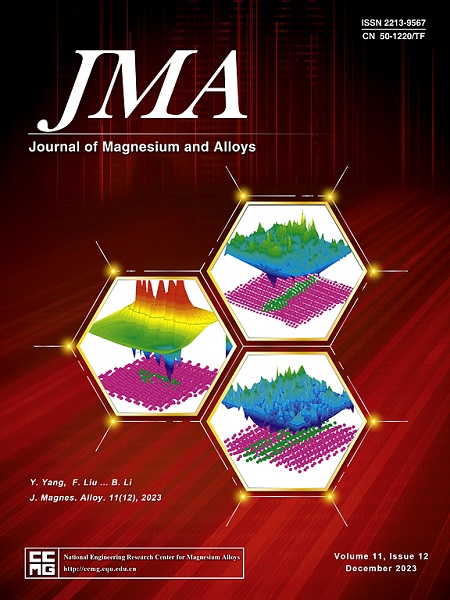用于骨再生膜的可生物降解纯镁固定钉:体外和体内评价
IF 13.8
1区 材料科学
Q1 METALLURGY & METALLURGICAL ENGINEERING
引用次数: 0
摘要
引导骨再生(GBR)依靠膜钉稳定屏障膜,促进骨愈合。然而,传统的钛钉需要二次去除手术,并可能损害成骨。镁(Mg)是一种可生物降解的金属,由于其可降解性、生物相容性和骨导电性,提供了一种很有前途的替代品。然而,镁基合金往往表现出快速和局部腐蚀,可能导致过早失效,从而限制了其临床应用。因此,在本研究中,采用两种不同纯度的纯Mg——商业纯Mg (CP-Mg,纯度:99.98 wt.%)和超高纯Mg (UHP-Mg,纯度:99.99937 wt.%)来制备膜钉,以提高膜钉的腐蚀性能。通过力学试验、体外腐蚀和细胞试验以及体内植入试验,研究了材料的力学性能、降解性能和生物学性能。结果表明,CP-Mg和UHP-Mg的晶粒尺寸分别为38µm和27µm。CP-Mg和UHP-Mg膜钉的剪切力均在55 N左右,两种材料间无明显差异,满足临床应用膜固定的实际要求。然而,体外腐蚀试验表明,UHP-Mg膜钉的降解速率明显低于CP-Mg膜钉,降解均匀性提高,可能会减轻由于快速局部降解而导致的过早机械失效。地窖试验表明,UHP-Mg具有优良的生物学性能。此外,体内实验表明,UHP-Mg膜钉植入后降解更缓慢、更均匀,在4周内未观察到位置迁移或脱离,实验期间未引起明显的炎症反应。降解区骨形态指标均优于CP-Mg膜钉,显示成骨能力增强。因此,UHP-Mg作为一种屏障膜固定钉材料具有很高的临床应用潜力。本研究为今后可降解镁植入物的临床应用提供了理论基础。本文章由计算机程序翻译,如有差异,请以英文原文为准。

Biodegradable pure Mg fixation nails for guided bone regeneration membrane: In vitro and in vivo evaluation
Guided Bone Regeneration (GBR) relies on membrane nails to stabilize barrier membranes and promote osseous healing. However, conventional titanium nails need secondary removal surgeries and may impair osteogenesis. Magnesium (Mg), a biodegradable metal, offers a promising alternative due to its degradability, biocompatibility, and osteoconductive properties. However, Mg-based alloys often exhibit rapid and localized corrosion, which may result in premature failure, thus limiting its clinical applicability. Therefore, in this study, two pure Mg with varying purity—commercially pure Mg (CP-Mg, purity: 99.98 wt.%) and ultrahigh-pure Mg (UHP-Mg, purity: 99.99937 wt.%)—were employed to fabricate the membrane nails to enhance their corrosion performance. The mechanical, degradation, and biological properties of the materials were studied by mechanical tests, in vitro corrosion and cell test, and in vivo implant tests. The results demonstrate that the grain sizes of CP-Mg and UHP-Mg are 38 µm and 27 µm, respectively. Both CP-Mg and UHP-Mg membrane nails are capable of shear forces of approximately 55 N, with no significant difference observed between the two materials, fulfilling the practical requirements for clinical applications in membrane fixation. However, in vitro corrosion test reveals that the degradation rate of UHP-Mg membrane nails is significantly lower than that of CP-Mg membrane nails, with improved degradation uniformity, which may mitigate premature mechanical failure resulting from rapid localized degradation. The cellar test shows that UHP-Mg has superior biological properties. Furthermore, in vivo experiments demonstrated that UHP-Mg membrane nails exhibited a slower and more uniform degradation post-implantation, with no positional migration or detachment observed within 4 weeks, and no significant inflammatory response was induced during the experimental period. Additionally, all bone morphology indices in the degraded area were superior to those in CP-Mg membrane nails, demonstrating enhanced osteogenesis. Therefore, UHP-Mg exhibits high potential for clinical application as a barrier membrane fixation nail material. This study provides a theoretical foundation for the future clinical application of degradable Mg implant devices.
求助全文
通过发布文献求助,成功后即可免费获取论文全文。
去求助
来源期刊

Journal of Magnesium and Alloys
Engineering-Mechanics of Materials
CiteScore
20.20
自引率
14.80%
发文量
52
审稿时长
59 days
期刊介绍:
The Journal of Magnesium and Alloys serves as a global platform for both theoretical and experimental studies in magnesium science and engineering. It welcomes submissions investigating various scientific and engineering factors impacting the metallurgy, processing, microstructure, properties, and applications of magnesium and alloys. The journal covers all aspects of magnesium and alloy research, including raw materials, alloy casting, extrusion and deformation, corrosion and surface treatment, joining and machining, simulation and modeling, microstructure evolution and mechanical properties, new alloy development, magnesium-based composites, bio-materials and energy materials, applications, and recycling.
 求助内容:
求助内容: 应助结果提醒方式:
应助结果提醒方式:


